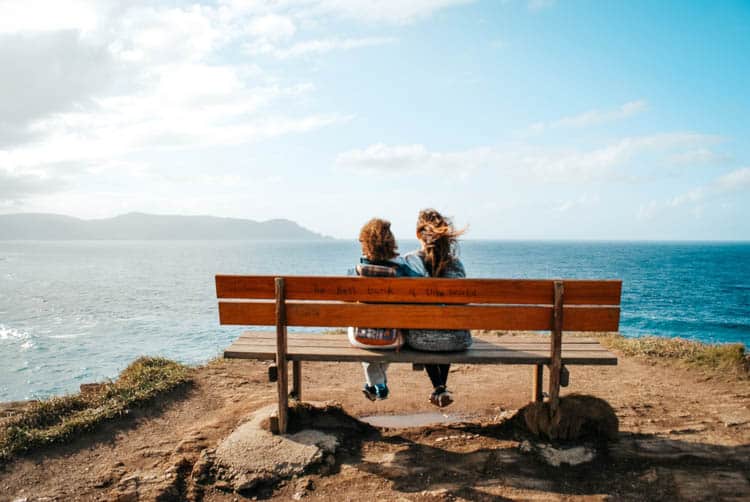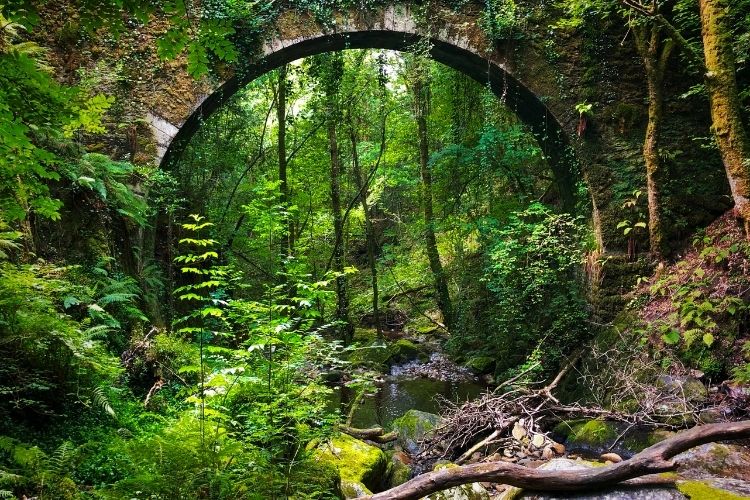
Go World Travel is reader-supported and may earn a commission from purchases made through links in this piece.
Galicia is a region located in the extreme northwest of Spain. It is perhaps best known for being the final destination of the Camino de Santiago pilgrimage, also known as the Way of St James. Galicia is best traveled slowly, as this is the pace that characterizes this land and its people.
Bewitched by the charm that envelops the north, there are a wide variety of magical places worth visiting. However, in this article, we will focus on 5 specific places of great beauty.
Read on as we take you from natural monuments to coastal viewpoints. Spend time sitting on one of the most beautiful benches in the world. Then stretch your legs on a little to walk along a beautiful path that leads to the sea.
Galicia is fairly unknown outside Spain. However, this region is full of breathtaking surprises just waiting to be discovered.
Top Sights in Galicia, Spain

San Andrés de Teixido
This small village in the town of Cedeira is known for housing the sanctuary of San Andrés de Teixido. This is where the supposed relics of San Andrés, one of the twelve apostles, are venerated.
Legend has it that San Andrés woke up sad one morning because no pilgrims were coming to his temple. God then granted him that, from that day on, no one could enter the Kingdom of Heaven without first visiting the temple.
Whoever did not do so in life, would have to do so in death. Hence the saying: “He who did not go to San Andrés de Teixido in life goes to San Andrés de Teixido in death”.
The baroque church of stone walls with white joints has become a famous place of pilgrimage full of legends. Today it is the second most popular pilgrimage place in Galicia, after Santiago de Compostela.
Walking through this village you get the feeling that time has not passed here. There are a few houses next to the sanctuary but the village is full of stalls where the locals sell offerings, amulets and liqueurs.
To get there you have to travel 12 kilometers from Cedeira, through the Capelada mountain range. As is often the case travelling to small villages in Galicia, Spain the winding road takes forever. But when you reach your final destination you will not regret it.
Very close to San Andrés de Teixido there is a magical place of vertiginous cliffs and an infinite sea. These are the cliffs of Vixia Herbeira. At 613 meters high they largest in continental Europe.
It is one of the most beautiful natural sites in Galicia from where you can observe how the cliffs fall almost vertically into a sea dotted with rocks.

Loiba Cliffs in Galicia, Spain
These cliffs, between 80 and 160 meters high, are home to what is known as the “best bench in the world”. The bench is located in O Coitelo. From here, with feet practically dangling over the cliffs, you can enjoy breathtaking views of the coast.
It is also a place to observe two of the best-known spots in the north of Galicia, Spain: Cape Ortegal to the west and Estaca de Bares to the east.
In 2009 a neighbor of the parish built the bench with his own hands so that people could enjoy the view. What he probably did not imagine is that years later this place would become an attraction for tourists from all over the world.
The magic of this bench lies in being able to enjoy the sea breeze and listen to the sound of the waves, feeling the sea nearby despite being high above it. The real treasure is not the bench but the place where it is located.
On the back is engraved “the best bank of the world”, because the person who made the inscription made a slight spelling mistake.
Far below the bench, erosion has created small rocky beaches. Accessing them is not easy. They must be reached through narrow, steep paths so most choose to observe them from the heights above. The beach of Picón is the exception with steps that make access easier.

Punta do Fuciño do Porco
This small path with views of the Cantabrian Sea and the Galician coast is a favorite of nature lovers and hikers. It is a coastal route of 5 kilometers along wooden walkways.
Its name means pig’s snout. It was named by the sailors who observed it from the sea and saw a resemblance to a pig nose.
Along this route, you can also enjoy views of the cliffs and see the remote beach of Pereira to the left. It can be said that this place has certain similarities with San Juan de Gaztelugatxe, in the Basque Country, one of the settings of the famous series Game of Thrones.

Fragas do Eume in Galicia, Spain
The Galician word “fraga” refers to a virgin forest located in isolated areas where the trees are tall and leafy and the light comes through the branches. This provides conditions of constant humidity and freshness that allow the development of unique plant heritage.
These are places of great scenic value for their diverse flora and fauna. Unfortunately, very few of them are preserved today.
These lush forests follow the course of the river Eume. The river gives them their name and is responsible for the rich biodiversity of this place. Here we can find everything from oak and chestnut trees to birch, ash and laurel trees. In this magical place, there are a thousand shades of green coloring the landscape.
It is characterized by being one of the best-preserved Atlantic forests and was declared a natural park in 1997. Less than 500 people live within its 9,000 hectares, making it a practically virgin place. Within the park, it is possible to follow seven different routes of varying difficulty and duration.

Beach of the Cathedrals
This marvelous beach is the perfect example of the power of the sea and the patience of time coming together to create natural works of art. It is popularly known as Playa de las Catedrales, as its rock formations remind us of the flying buttresses of a Gothic cathedral.
Over the centuries, the powerful waters of the Cantabrian Sea and its constant battering have sculpted these amazing shapes in the cliffs. It is one of the most beautiful and special beaches in Spain, with arches over 30 meters high as well as passages and deep caves.
It is important to check the tides, as it is only possible to walk along the beach at low tide. At high tide, the beach must be enjoyed from the cliffs due to the rough sea.
More and more tourists are wanting to come and observe this natural wonder. For this reason, the number of visitors has been limited during peak periods, such as summer, to preserve the place. During this time, prior permission is required to visit the beach.
Book This Trip
Ready to plan a coastal adventure to Galicia? Get prepared with knowledge on how to get around, hotel and VRBO accommodations, local restaurant and shop reviews and more through TripAdvisor and Travelocity.
Make the most of your trip by booking unique activities in Galicia, skip-the-line tickets, beach fun and expert-led tours through GetYourGuide. Find more information and book your dates in advance here.
More helpful links:
- Booking a visit to Cathedrals Beach (xunta.gal)
- Punta Fuciño do Porco – Information and online booking (puntafucinodoporco.gal)
Author Bio: Based in France, Lucia Otero Medraño is Spanish with a master’s degree in travel journalism. She has worked in the tourism sector but her true passion is to live enriching experiences and discover amazing places around the world and write about them. In her spare time, she likes to enjoy her second passion, music.

